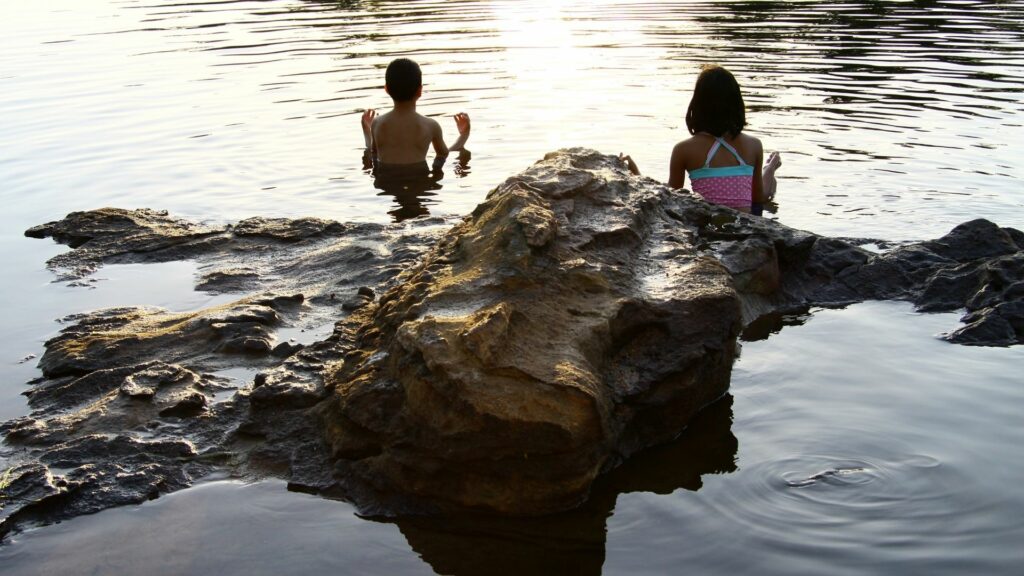Contents
Meditation For Kids For Good Mental Health
Meditation is an ancient practice that has been shown to be effective in reducing stress and anxiety. Many meditation techniques are easy for children to understand, but it can be hard to know which meditation technique will work best for your child. This guide provides many meditation techniques for kids along with explanations of how these meditation practices work.
What Is Meditation?
 Meditation is a way that can make people feel calmer. It can also show them what they know about themselves and how they feel.
Meditation is a way that can make people feel calmer. It can also show them what they know about themselves and how they feel.
When you meditate, you focus on the relationship between your brain, mind, body, and behavior. You want to move into a peaceful and energized state of mind.
There are many types of meditation. They all share four things:
- In a quiet location, it is quieter
- A comfortable position to be in is sitting, lying down, or walking
- A focus of attention is the main thing that people are looking at
- You need to be open-minded
For kids, you should start with a shorter time of meditation and then add on as they get better. For adults, have more patience and can stay focused for a longer period of time.
Meditation is a practice that helps people relax and work on their thoughts. It can be difficult for young children to do because they don’t know what it is. We need to introduce it in a way that makes sense to them, such as with toys or stories. Parents should encourage their kids to find a type of meditation that they like to do. It is important for them to feel connected and want to continue doing it every day.
Why Meditation for Kids?

It is important to teach children how to take care of their minds as well as their bodies. Introducing children to meditation early on can help them be calm and know how to handle stress. When they grow up, they will know how to control their emotions.
But sometimes, it is hard to get a toddler or a preschooler to sit still. That’s why meditation needs to be done at their level. Here, we teach you about meditation. It has good things in it for you. The tips are so that children can learn how to do it too.
The Benefits of Meditation
 Even in its simplest forms, meditation can help people find calm. There are benefits to it after three or four sessions.:
Even in its simplest forms, meditation can help people find calm. There are benefits to it after three or four sessions.:
- Sleep is important. If you sleep, then you will feel better.
- Reduced anxiety
- Improved self-esteem is when you feel good about yourself.
- Ability to focus on things and study
- Less stress.
Kids have advantages when learning to meditate. They are more willing to try new things, and they are honest about what they don’t like. Yet, there are some things that kids cannot do just because of how their bodies work. Kids can’t sit still the same way adults can.
Adults can concentrate but it might take a long time to relax. We often come with a lot of baggage and when we try to relax, we might think about things that need to be processed first. A body scan usually takes 30 minutes.
Best Time To Teach Kids Meditation
Introducing or practicing meditation with your child will teach them about it. You can do this by either introducing it to them or letting them practice. If you practice with kids when they are calm, it will be easier for them to do this when they get stressed and can’t calm down. Adults need to provide a structure for children so that the skill of calming down is not just something they learn but also something they use.
You can make meditation part of your bedtime or morning routine. It might help you feel better. You can also start this when you are a young child like 3 or 4 years old and learn how to breathe. Teens can practice 5 minutes of meditation. It is good if you join them, but it is okay if you do not.
Instead of joining a friend, you can help them find a space that is quiet and safe where they can be alone. They will have time to think about the bad things that happened today.
Getting Started With Meditation
 To teach meditation for kids techniques, you must start your own practice and get used to going off-script. You do not need lots of experience. Just focus on your out-breath for as long as you can from the start to the finish. Feel the sound and sensation.
To teach meditation for kids techniques, you must start your own practice and get used to going off-script. You do not need lots of experience. Just focus on your out-breath for as long as you can from the start to the finish. Feel the sound and sensation.
Kids need adults to be around them who behave in ways they can copy. They also need to hear and feel that their adults know them well enough so that the kids can meditate with their parents on days when they are feeling down. Trust your intuition for what is best for your child, and the connection between you will grow stronger when you continue meditation.
How To Teach Toddlers And Preschoolers To Meditate?

You can teach toddlers and preschool-age kids how to meditate at home. This is because, for kids, it’s like they are doing what their parents do. So if their parents do meditation, the kids should too.
Meditating with your kids is good. It can be hard to try to start this, but it will become easier if you do it every day. The best way to start is by taking deep breaths and then meditating. Here are some tips on how to do meditative breathing:
Have them sit in a comfortable position: You can try a yoga pose, like a baby cobra. The child should sit cross-legged.
Teach them about connecting with their bodies: For example, tell them to watch their stomach move in and out when they take a deep breath.
Reinforce the why: Meditation is good for you. It can make you feel better about yourself and help with things like headaches. Listen to a meditation tape or try it in the morning when you wake up.
It is important to remember that meditation for kids is essential and still be kids. Yes, they might wiggle or laugh the first few times, but this means that you should practice and be patient.
Meditation for Toddlers
 For children who are young learners, meditation can be more like doing a type of movement. When you have a discussion about things that make your child happy and ask them to touch the parts of their body that feel good when they are happy, the child is moving in a way that feels good. When people are feeling bad, they might not breathe right. Think of something that is unhappy and where they feel it in their body. It might be a deep breath or a hug from a friend.
For children who are young learners, meditation can be more like doing a type of movement. When you have a discussion about things that make your child happy and ask them to touch the parts of their body that feel good when they are happy, the child is moving in a way that feels good. When people are feeling bad, they might not breathe right. Think of something that is unhappy and where they feel it in their body. It might be a deep breath or a hug from a friend.
You train your brain to know that when it feels stressed, it can do things that will make the body feel better. (And if you think this sounds like something impossible, she says that we teach kids how to go to the bathroom when they need to be showing them what to do.)
Toddlers are not bad. When they fidget, it is because their bodies and brains are developing. They don’t have many words to tell you when they are making big leaps in understanding or need to self-soothe. You want to meet the children where they’re at. If it’s 30 seconds, great. Let’s do 30 seconds. If you know your body signals well, you’ll take care of yourself even when no adults are around.
Meditation for Preschoolers
 Starting around age 3 or 4, children start to focus on the details in a story. Try guiding your child with your voice to think about how each part of their body feels from head to toe when they are calm. Try to calm your child by telling him/her a story about a favorite pet or toy. If your child is still resisting, try some other techniques like focusing on breathing. “You can do the techniques with commitment, and kids will start to engage.”
Starting around age 3 or 4, children start to focus on the details in a story. Try guiding your child with your voice to think about how each part of their body feels from head to toe when they are calm. Try to calm your child by telling him/her a story about a favorite pet or toy. If your child is still resisting, try some other techniques like focusing on breathing. “You can do the techniques with commitment, and kids will start to engage.”
Meditation for Older Kids

Some kids are calm when they hear meditative music. But you should let your child choose the voice or sound texture that makes them feel comfortable.
Meditation music often uses Tibetan singing bowls. These bowls make sounds that can heal and restore parts of the body. Children with autism spectrum disorder like these sounds. And other children like nature sounds and feel calm and peaceful when they hear them.
Here are some websites you should try. The first one is for meditation, and the second one has music.
Insight Timer — This trove of more than 30,000 guided meditations and recordings for children, beginning, and advanced practitioners is a veritable goldmine of inspiration. It’s available online as well as as an app.
“Mindful Kids” YouTube channel — This channel collects thousands of music and narrative videos. Explore alternatives with your child, and trust your instincts. “Give yourself permission to believe that voice if you see something and your gut tells you to.”
Stop, Breathe & Think — This app is meant to assist children ages 5-10 with focus, quiet, peaceful sleep, and processing emotions. Your child will learn how to concentrate and check-in with herself. She’ll get stickers for completing “missions” as a result of doing so.
Meditation For Teens
 A key to meditation is to train your mind to ignore the “noise” from our stressful world. You do this by focusing on your body. For teens, guided meditation asks them to take a safe-place journey where they use all of their senses. Here are the steps of that journey:
A key to meditation is to train your mind to ignore the “noise” from our stressful world. You do this by focusing on your body. For teens, guided meditation asks them to take a safe-place journey where they use all of their senses. Here are the steps of that journey:
- Think about a safe place.
- Notice what you see. What do you feel? What color is it? Is there a texture?
- Can you feel soft things, like a pillow? Or can you feel hard things, like sand?
- Take a close look at the smell. Is it sweet, savory, or something you know?
It is good for teens to know what they need to do. They can say hello, see what it is and then let go of the list with their breath.
It’s important to explore different types of meditation that might be good for your teen. For example, if your teen likes art, try a focused meditation like coloring mandalas. If they are into sports, try yoga with them. It doesn’t matter what the type of practice is–just make sure you are doing it together.
Conclusion
With so many different types of meditations for kids, it can be hard to know which one will work best. This guide provides a list of the most popular and accessible meditation tips that children enjoy and benefit from. Whether you’re looking for something gentle or more active, we hope this article has given you some new ideas! If your child is interested in getting started with meditation but doesn’t know where to start, don’t hesitate to reach out – our team would love to chat about how they could get involved.
For more information and Guidance, please contact MantraCare. If you have any queries regarding Online Child Counseling or Teen Counseling experienced therapists at MantraCare can help: Book a trial therapy session


